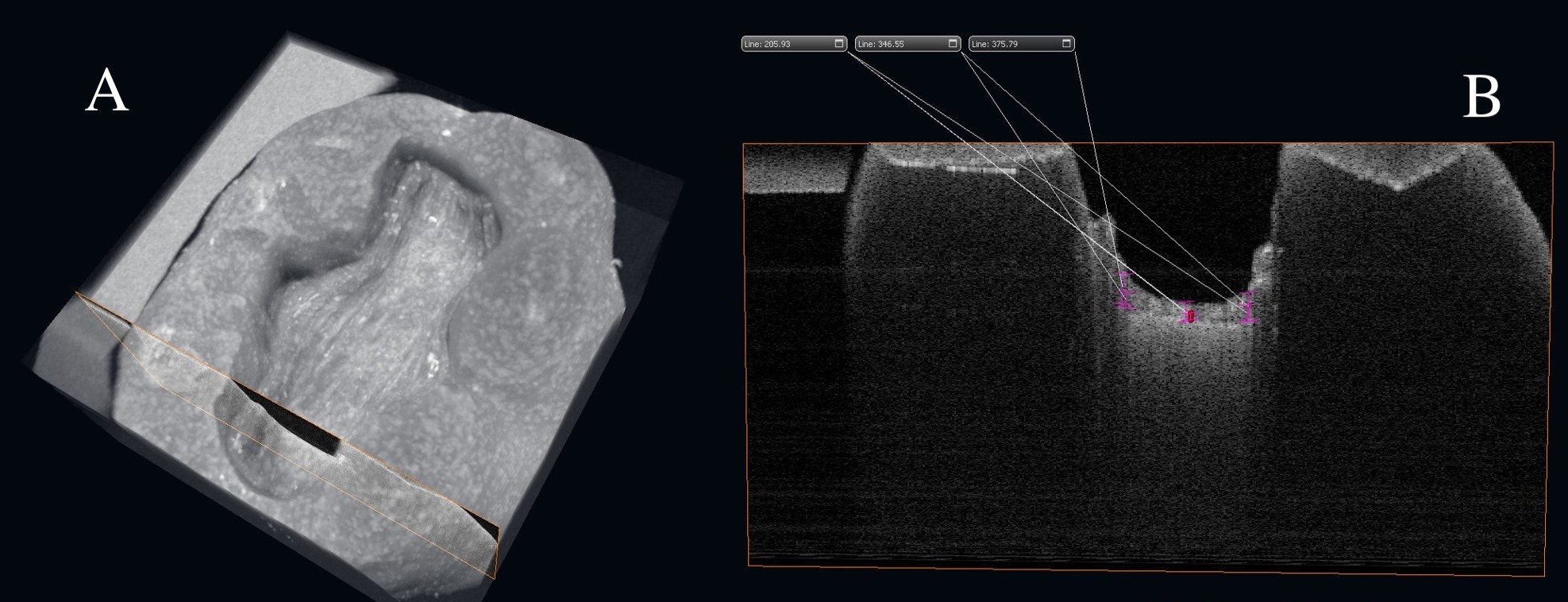IADR Abstract Archives
Integrity of Woven Polyethylene Fiber-Reinforced Composite Laminates in Deep Preparations
Objectives: Chairside incorporation of ultra-high molecular-weight polyethylene (UHMWPE) continuous fiber into composite resin reduces stress and controls rack growth. Optimal adaptation of the fiber-reinforced composite (FRC) laminate to dentin surface is desirable. This study aimed to compare the thickness and adaptation of FRC laminating a deep preparation using different composites and placement techniques.
Methods: Identical epoxy resin molds of a wide and deep occlusal preparation on lower first molar were replicated and treated with bonding agent (Clearfil SE Bond 2, Kuraray Noritake Dental), 4-mm wide 10-mm long fiber (THM Ultra, Ribbond) was wetted with unfilled resin. A flowable composite was placed in the cavity followed by close adaptation of the wetted fiber in 3 groups; TAC: Tacky composite (Ribbond); FLW: Filtek Flowable (3M); SFC: short-fiber reinforced composite everX Flow (GC). In the fourth group; HYB: a small amount of Filtek Supreme Ultra hybrid composite (3M) was placed on the wetted fiber, and the fiber and composite were placed and adapted onto the cavity together. Excess composite was removed in all groups before light polymerization. A 3D optical coherence tomography (Yoshida Dental OCT) scan was obtained and analyzed to measure total thickness (TT), resin thickness (RT) and void (VD) at various locations in all specimens (n=7/group).
Results: TT measured 418±129, 371±84, 426±122 and 459±112 while RT was 225±96, 212±77, 265±106 and 290±110 for TAC, FLW, SFC and HYB, respectively (mean±SD, µm). Multifactorial ANOVA showed that materials and locations had a significant effect on TT (p<0.001) and RT (p<0.005), while the interactions were not significant (p>0.05). FLW was significantly different from HYB and SFC in TT (p<0.001). For RT, SFC presented the thickest layer significantly different from all groups followed by HYB (p<0.05). Void frequency per specimen was significantly different among groups (p<0.05), with the highest voids observed in FLW.
Conclusions: Adaptation and integrity of UHMWPE continuous FRC to preparation walls depended on the cavity geometry, the technique and materials used for its lamination.
Methods: Identical epoxy resin molds of a wide and deep occlusal preparation on lower first molar were replicated and treated with bonding agent (Clearfil SE Bond 2, Kuraray Noritake Dental), 4-mm wide 10-mm long fiber (THM Ultra, Ribbond) was wetted with unfilled resin. A flowable composite was placed in the cavity followed by close adaptation of the wetted fiber in 3 groups; TAC: Tacky composite (Ribbond); FLW: Filtek Flowable (3M); SFC: short-fiber reinforced composite everX Flow (GC). In the fourth group; HYB: a small amount of Filtek Supreme Ultra hybrid composite (3M) was placed on the wetted fiber, and the fiber and composite were placed and adapted onto the cavity together. Excess composite was removed in all groups before light polymerization. A 3D optical coherence tomography (Yoshida Dental OCT) scan was obtained and analyzed to measure total thickness (TT), resin thickness (RT) and void (VD) at various locations in all specimens (n=7/group).
Results: TT measured 418±129, 371±84, 426±122 and 459±112 while RT was 225±96, 212±77, 265±106 and 290±110 for TAC, FLW, SFC and HYB, respectively (mean±SD, µm). Multifactorial ANOVA showed that materials and locations had a significant effect on TT (p<0.001) and RT (p<0.005), while the interactions were not significant (p>0.05). FLW was significantly different from HYB and SFC in TT (p<0.001). For RT, SFC presented the thickest layer significantly different from all groups followed by HYB (p<0.05). Void frequency per specimen was significantly different among groups (p<0.05), with the highest voids observed in FLW.
Conclusions: Adaptation and integrity of UHMWPE continuous FRC to preparation walls depended on the cavity geometry, the technique and materials used for its lamination.

